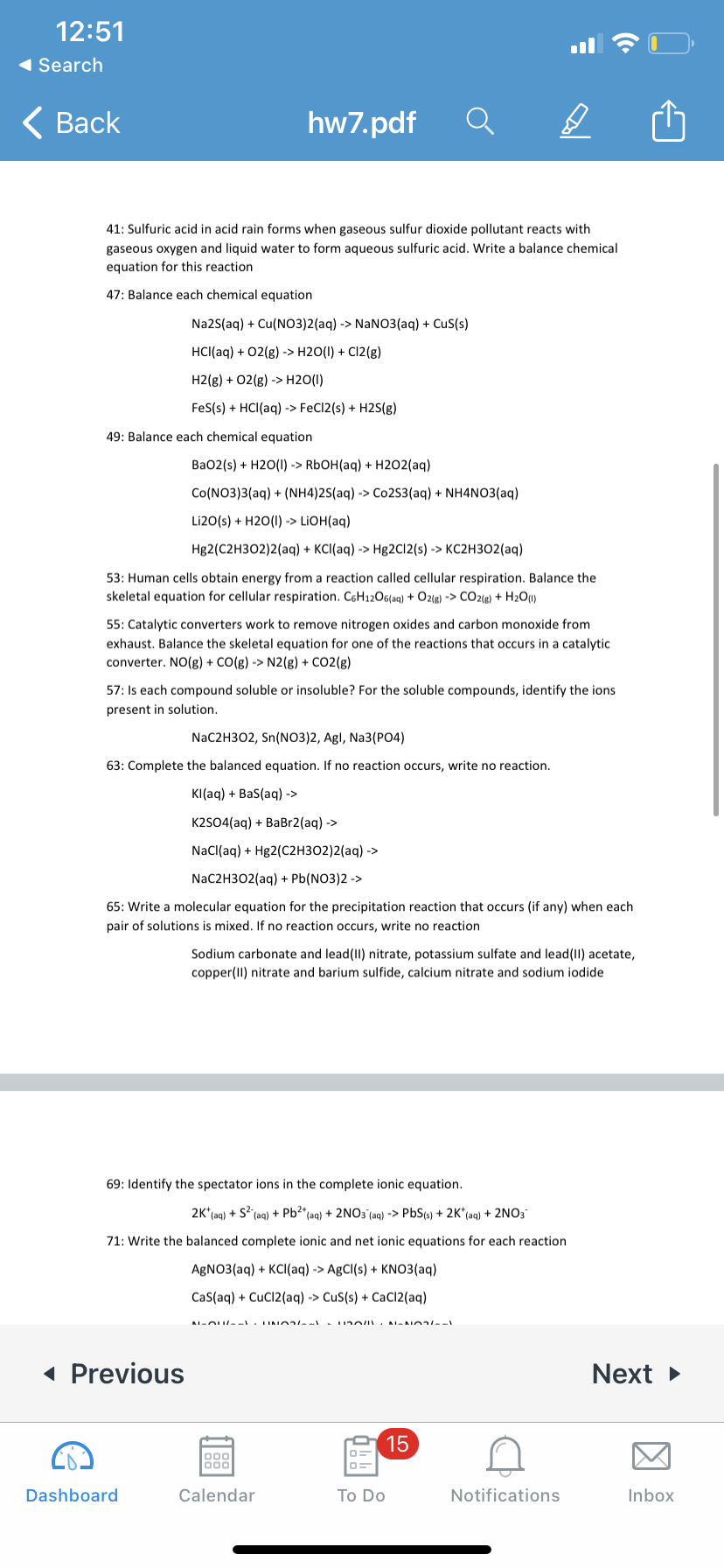47: Balance each chemical equation Na2S(aq) + Cu(NO3)2(aq) -> NaNO3(ag) + CuS(s) HCI(aq) + 02(g) -> H2O(I) + C12(g) H2(g) + 02(g) -> H2O(I) FeS(s) + HCI(aq) -> FeC12(s) + H2S(g)
47: Balance each chemical equation Na2S(aq) + Cu(NO3)2(aq) -> NaNO3(ag) + CuS(s) HCI(aq) + 02(g) -> H2O(I) + C12(g) H2(g) + 02(g) -> H2O(I) FeS(s) + HCI(aq) -> FeC12(s) + H2S(g)
Chemistry & Chemical Reactivity
10th Edition
ISBN:9781337399074
Author:John C. Kotz, Paul M. Treichel, John Townsend, David Treichel
Publisher:John C. Kotz, Paul M. Treichel, John Townsend, David Treichel
Chapter20: Environmental Chemistry-earth's Environment, Energy, And Sustainability
Section: Chapter Questions
Problem 41PS
Related questions
Question
Question 47.

Transcribed Image Text:12:51
1 Search
< Вack
hw7.pdf
41: Sulfuric acid in acid rain forms when gaseous sulfur dioxide pollutant reacts with
gaseous oxygen and liquid water to form aqueous sulfuric acid. Write a balance chemical
equation for this reaction
47: Balance each chemical equation
Na2S(aq) + Cu(NO3)2(aq) -> NANO3(aq) + CuS(s)
HCI(aq) + 02(g) -> H2O(I) + Cl2(g)
H2(g) + 02(g) -> H2O(I)
FeS(s) + HCI(aq) -> FeC12(s) + H2S(g)
49: Balance each chemical equation
Ba02(s) + H2O(1) -> RBOH(aq) + H2O2(aq)
Co(NO3)3(aq) + (NH4)2S(aq) -> Co2S3(aq) + NH4NO3(ag)
Li20(s) + H20(1) -> LIOH(aq)
Hg2(C2H302)2(аq) + кС{аq) -> Hg2CI2(s) -> KС2H302(аq)
53: Human cells obtain energy from a reaction called cellular respiration. Balance the
skeletal equation for cellular respiration. C6H12O6(aq) + O2(g) -> CO2(®) + H2O1)
55: Catalytic converters work to remove nitrogen oxides and carbon monoxide from
exhaust. Balance the skeletal equation for one of the reactions that occurs in a catalytic
converter. NO(g) + CO(g) -> N2(g) + CO2(g)
57: Is each compound soluble or insoluble? For the soluble compounds, identify the ions
present in solution.
NaC2H302, Sn(NO3)2, Agl, Na3(РО4)
63: Complete the balanced equation. If no
ion occurs,
no reaction.
KI(aq) + BaS(aq) ->
K2SO4(aq) + BaBr2(aq) ->
NaCl(aq) + Hg2(C2НЗ02)2(аq) ->
NaC2H3O2(aq) + Pb(NO3)2 ->
65: Write a molecular equation for the precipitation reaction that occurs (if any) when each
pair of solutions is mixed. If no reaction occurs, write no reaction
Sodium carbonate and lead(II) nitrate, potassium sulfate and lead(II) acetate,
copper(II) nitrate and barium sulfide, calcium nitrate and sodium iodide
69: Identify the spectator ions in the complete ionic equation.
2K*(aq) + S? (aq) + Pb2"(aq) + 2NO3 (aq) -> PbS(s) + 2K* (aq) + 2NO3
71: Write the balanced complete ionic and net ionic equations for each reaction
AGNO3(aq) + KCI(aq) -> AgCI(s) + KNO3(aq)
Cas(aq) + CuCl2(aq) -> CuS(s) + CaCI2(aq)
« Previous
Next >
15
000
Dashboard
Calendar
Тo Do
Notifications
Inbox
Expert Solution
This question has been solved!
Explore an expertly crafted, step-by-step solution for a thorough understanding of key concepts.
This is a popular solution!
Trending now
This is a popular solution!
Step by step
Solved in 2 steps

Knowledge Booster
Learn more about
Need a deep-dive on the concept behind this application? Look no further. Learn more about this topic, chemistry and related others by exploring similar questions and additional content below.Recommended textbooks for you

Chemistry & Chemical Reactivity
Chemistry
ISBN:
9781337399074
Author:
John C. Kotz, Paul M. Treichel, John Townsend, David Treichel
Publisher:
Cengage Learning

Chemistry & Chemical Reactivity
Chemistry
ISBN:
9781133949640
Author:
John C. Kotz, Paul M. Treichel, John Townsend, David Treichel
Publisher:
Cengage Learning

Principles of Modern Chemistry
Chemistry
ISBN:
9781305079113
Author:
David W. Oxtoby, H. Pat Gillis, Laurie J. Butler
Publisher:
Cengage Learning

Chemistry & Chemical Reactivity
Chemistry
ISBN:
9781337399074
Author:
John C. Kotz, Paul M. Treichel, John Townsend, David Treichel
Publisher:
Cengage Learning

Chemistry & Chemical Reactivity
Chemistry
ISBN:
9781133949640
Author:
John C. Kotz, Paul M. Treichel, John Townsend, David Treichel
Publisher:
Cengage Learning

Principles of Modern Chemistry
Chemistry
ISBN:
9781305079113
Author:
David W. Oxtoby, H. Pat Gillis, Laurie J. Butler
Publisher:
Cengage Learning

EBK A SMALL SCALE APPROACH TO ORGANIC L
Chemistry
ISBN:
9781305446021
Author:
Lampman
Publisher:
CENGAGE LEARNING - CONSIGNMENT